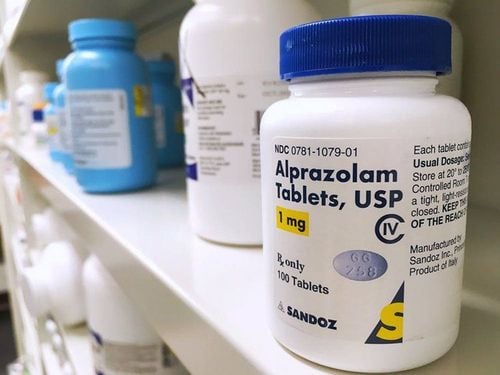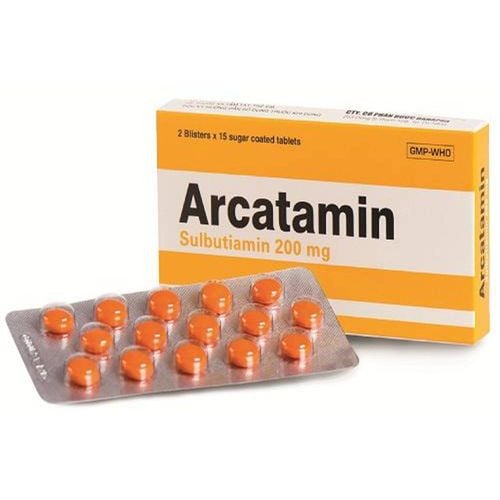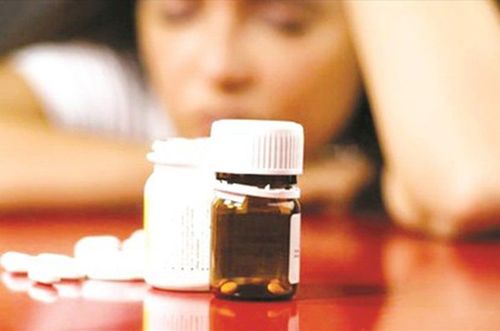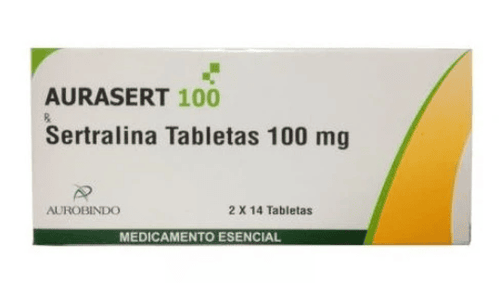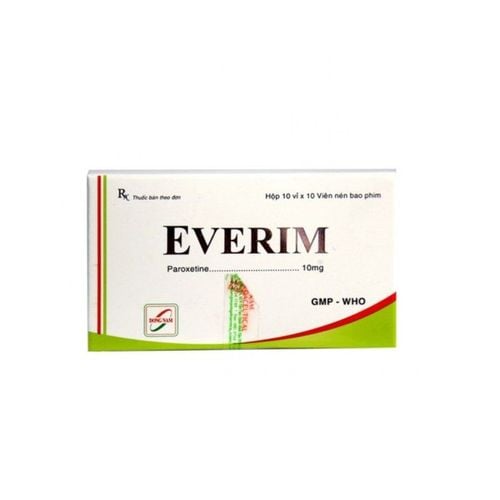This is an automatically translated article.
Paxine 20 is manufactured and registered by Synmedic Laboratories Company - India, belongs to the group of psychotropic drugs. Refer to the article below for more useful information about Paxine 20.
1. What is Paxine?
Paxine 20mg medicine contains the main active ingredient is Paroxetin HCl 20mg, is prepared in the form of film-coated tablets, packed in boxes of 10 blisters, 1 blister contains 10 tablets.
2. Effects and indications of Paxine 20mg
Effects of the drug Paxine 20:
Active ingredient Paroxetin is a component of the group of selective Seretonin reuptake inhibitors (SSRIs) with antidepressant effects, reducing stress, reducing anxiety, ... Indications of Paxine 20:
Paxine 20mg is indicated for use in the following cases: Depression; Obsessive-compulsive disorder; Panic disorder ; Disorders caused by traumatic stress, psychological trauma; Social anxiety disorder; Generalized anxiety disorder;
3. Usage is the dosage of Paxine 20mg
How to take Paxine 20:
Paxine 20 is taken orally, take it whole, do not chew, crush or bite the pill, take it once a day in the morning, the use of the drug does not depend on the meal. Dosage of the drug Paxine 20:
For severe depression, anxiety depression, reactive depression, use a dose of 20mg / day, if the dose does not respond, gradually increase to 10mg every day and maximum daily 50mg. For obsessive-compulsive disorder: Use 40mg daily, but only 20mg should be used initially, increased weekly to 10mg, maximum dose is only 60mg/day. For panic disorder: The initial dose of 10 mg/day may be increased gradually to 40 mg/day; however, if no response is observed, the dose may be increased gradually to a maximum of 60 mg/day. When it is necessary to stop the drug, it should be stopped gradually. In subjects with underlying liver or severe renal impairment, the dose should be reduced to half: 20 mg/day. For generalized anxiety disorder, social anxiety disorder: Use a starting dose of 20mg per day, if the dose is not responding, it can be increased gradually, to a maximum dose of 50mg per day. For post-traumatic stress disorder or post-traumatic stress disorder: Initial dose 20 mg/day, maintenance dose 20 to 50 mg once daily. For the elderly or people with weak health: Only use the starting dose is 10mg, not more than 40mg in a day. During the use of the drug, the patient must fully comply with the instructions of the treating doctor to bring about high results.
4. Contraindications of Paxine 20mg
Do not use Paxine 20 for the following subjects:
Patients who are sensitive to any ingredient of the drug, including the main active ingredient and excipients in Paxine 20. Within 2 weeks of stopping treatment treatment or patients taking MAOIs, the use of Paxine 20 is not indicated in this population. Do not combine Paxine 20 with Pimozid , Thioridazine , Linezolid . Not for use by pregnant women, lactating mothers and children under 18 years of age.
5. Undesirable effects
Paxine 20 may cause other side effects such as:
Common side effects: dizziness, fatigue, yawning, sweating, weight gain, weakness, tremor, headache, impaired sexual function , decreased concentration, nausea, constipation, diarrhea, dry mouth, loss of appetite, blurred vision, sweating, insomnia, restlessness, anxiety, agitation, nightmares, increased cholesterol levels. Uncommon side effects: extrapyramidal reactions, hallucinations, confusion, pruritus, skin rash, abnormal bleeding under the skin, orthostatic hypotension, tachycardia, blood pressure disturbances, urinary incontinence , urinary retention, pupil dilation. Less common side effects: arthralgia, myalgia, peripheral edema, bradycardia, thrombocytopenia, serotonin syndrome, convulsions, anxiety, dyskinesia, agitation, restless legs syndrome, gastrointestinal bleeding, gynecomastia, hyperprolactinemia, lactation, Stevens-Johnson syndrome, skin rash, maculopapular, toxic epidermal necrolysis, cholestatic jaundice, hepatitis, hyponatremia blood. Advise patients when experiencing any unwanted effects, should notify the treating doctor for instructions on handling and treating symptoms promptly to ensure effective treatment and limit symptoms. severe illness occurs.
6. Drug interactions
Some drugs and foods should not be used during treatment with Paxine 20mg:
For MAO drugs, it is necessary to use Paxine 20 2 weeks after finishing treatment with MAOIs and vice versa. Patients need to provide information about drugs that have been used or intend to use during treatment with Paxine 20 such as: Metoprolol, Atomoxetine, Procyclidine, Cimetidine, Tamoxifen, St. John's alcohol, Tryptophan, anti-inflammatory drugs. blood clotting (Coumadin, Warfarin), medicine for HIV, AIDS, medicine for arrhythmia. Do not use together Paxine 20 with narcotic pain relievers such as Tramadol, Fentanyl; medicine to treat mood disorders, mental illness, or thought disorders such as Lithium, other antipsychotics or antidepressants. Migraine medications such as: Zolmitriptan, Sumatriphan, Rizatriptan, and others, Phenytoin, Carbamazepine. The combined use of Paxine 20 with NSAIDs/acetylsalicylic acid may increase the risk of bleeding. Drugs that affect gastric pH may affect plasma concentrations of paroxetin.
7. Pay attention to the use of Paxine 20mg
Use caution when administering Paxine 20 to patients with liver failure, renal failure, cardiovascular disease or diabetes. Do not use Paxine 20 and adolescents under 18 years of age. Do not use Paxine 20 for women who are pregnant and breastfeeding. The drug can cause mania or hypomania, psychomotor disturbances should be used with caution in patients with a history of mania. Above is some information to share about what is Paxine 20. To ensure safety for your health and maximize the effectiveness of your treatment, you need to take Paxine 20 exactly as directed by your doctor.
Please dial HOTLINE for more information or register for an appointment HERE. Download MyVinmec app to make appointments faster and to manage your bookings easily.





